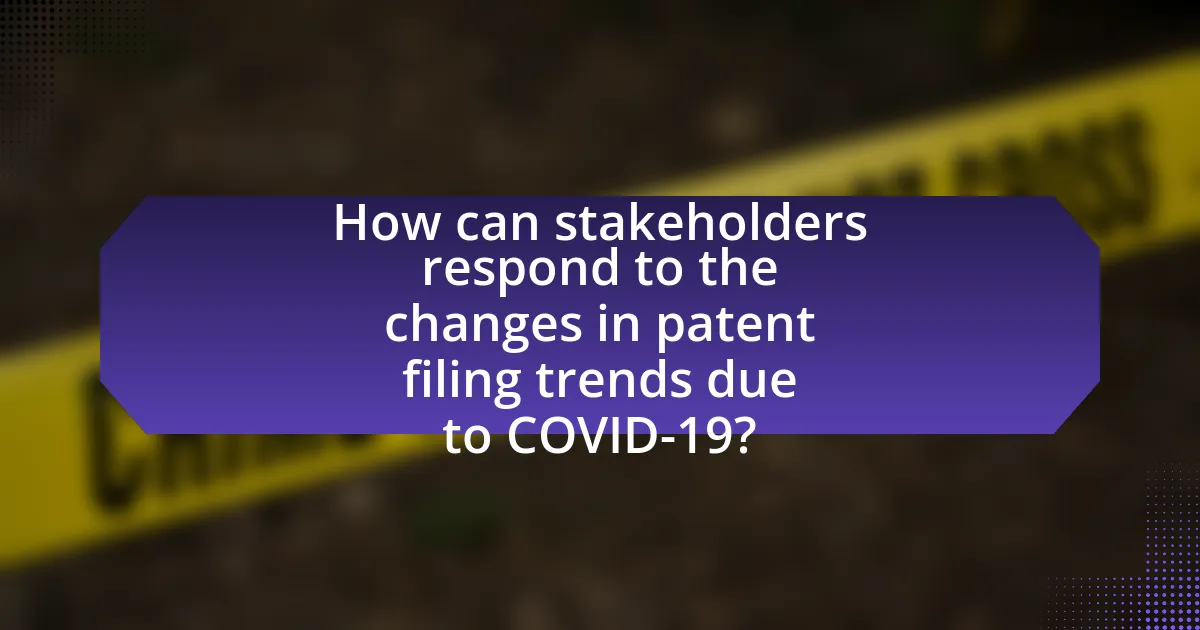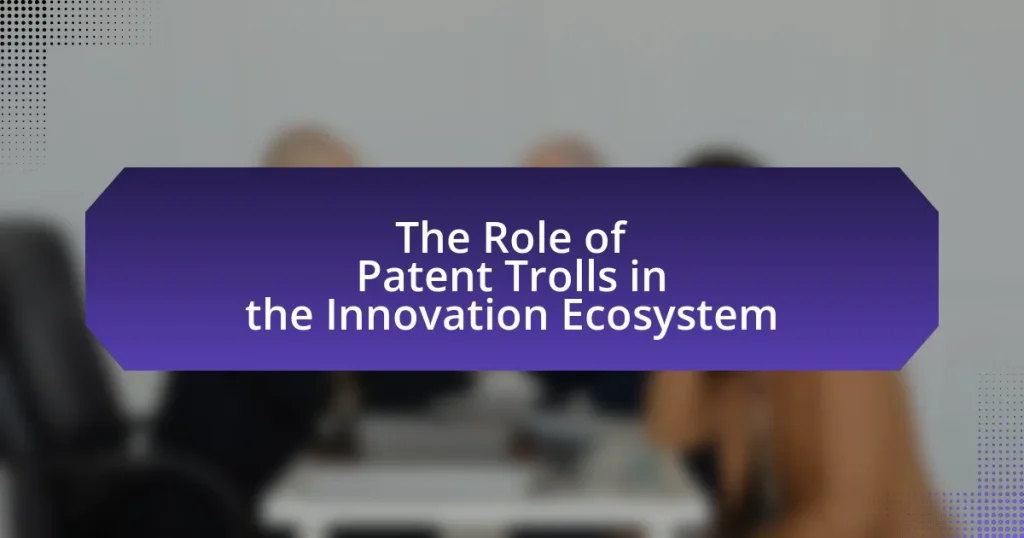The article examines the significant impact of COVID-19 on global patent filing trends, highlighting a notable decline in applications during the early months of the pandemic, followed by a resurgence in specific sectors such as healthcare and technology. Data from the World Intellectual Property Organization (WIPO) indicates a 6% drop in global patent applications in 2020, contrasted by a 1.6% increase in 2021, driven by innovations related to medical technologies and digital solutions. The article further explores the factors influencing these trends, including economic conditions, remote work dynamics, and shifts in innovation focus, while also discussing the long-term implications for patent filings and strategies for businesses to adapt in a post-pandemic landscape.

What is the Impact of COVID-19 on Patent Filing Trends?
The impact of COVID-19 on patent filing trends has been significant, with a notable decline in filings during the early months of the pandemic. According to the World Intellectual Property Organization (WIPO), global patent applications dropped by approximately 6% in 2020 compared to the previous year, reflecting disruptions in business operations and economic uncertainty. However, as the situation evolved, there was a resurgence in filings, particularly in sectors related to healthcare and technology, indicating a shift in innovation focus. By 2021, patent filings rebounded, with a reported increase of around 1.6% from 2020, driven by advancements in medical technologies and digital solutions. This trend illustrates how the pandemic has reshaped the landscape of innovation and intellectual property.
How has the COVID-19 pandemic influenced global patent filing rates?
The COVID-19 pandemic has led to a significant increase in global patent filing rates, particularly in sectors related to healthcare and technology. According to the World Intellectual Property Organization (WIPO), patent applications rose by 1.6% in 2020, despite the pandemic’s economic challenges. This surge was driven by innovations aimed at combating the virus, such as vaccines and medical technologies, as well as a shift towards digital solutions and remote work technologies. The pandemic highlighted the importance of intellectual property in fostering innovation, resulting in a more proactive approach to patent filings in various industries.
What specific changes in patent filing volumes have been observed during the pandemic?
During the pandemic, patent filing volumes experienced a notable decline in the early months, followed by a subsequent recovery and increase. Specifically, the World Intellectual Property Organization reported a 16% drop in international patent applications in April 2020 compared to the previous year, attributed to disruptions caused by COVID-19. However, by the latter half of 2020, filings rebounded, with a 1.6% increase in global patent applications reported for the entire year, indicating a shift in innovation focus towards health technologies and digital solutions. This trend highlights the pandemic’s dual impact on patent activity, initially suppressing filings but ultimately leading to a surge in specific sectors.
How do these changes compare to pre-pandemic filing trends?
Patent filing trends during the pandemic have shown a significant increase compared to pre-pandemic levels. For instance, data from the World Intellectual Property Organization indicates that global patent applications rose by 1.6% in 2020, despite the pandemic’s challenges, contrasting with a decline of 0.6% in 2019. This shift reflects a heightened focus on innovation and technology, driven by the urgent need for solutions to pandemic-related issues, such as healthcare advancements and digital transformation.
What factors contributed to changes in patent filing during COVID-19?
Changes in patent filing during COVID-19 were primarily influenced by shifts in innovation focus, economic uncertainty, and remote work dynamics. The pandemic prompted a surge in healthcare-related inventions, particularly in pharmaceuticals and medical devices, as companies sought to address urgent public health needs. Economic uncertainty led many businesses to delay or reduce their patent filings due to budget constraints and a focus on immediate survival rather than long-term innovation. Additionally, the transition to remote work affected collaboration and the pace of research and development, further impacting the volume of patent applications. According to the World Intellectual Property Organization, global patent filings saw a decline of 1.6% in 2020, reflecting these trends.
How did economic conditions during the pandemic affect innovation and patenting?
Economic conditions during the pandemic significantly hindered innovation and patenting activities. The global economic downturn led to reduced investment in research and development, as companies faced financial constraints and uncertainty. According to a report by the World Intellectual Property Organization (WIPO), patent filings dropped by 3.5% in 2020 compared to the previous year, marking the first decline in a decade. This decline was particularly evident in sectors heavily impacted by the pandemic, such as travel and hospitality, where companies diverted resources away from innovation efforts. Conversely, some sectors, like pharmaceuticals and technology, saw a surge in patent applications related to COVID-19 solutions, indicating that while overall patenting decreased, specific areas experienced growth driven by urgent needs.
What role did remote work and digital transformation play in patent filings?
Remote work and digital transformation significantly increased patent filings during the COVID-19 pandemic. As companies adapted to remote operations, they accelerated innovation in technology and processes, leading to a surge in new inventions and ideas that required patent protection. For instance, the World Intellectual Property Organization reported a 1.6% increase in global patent applications in 2020, driven by advancements in digital technologies and remote work solutions. This trend highlights how the necessity for digital tools and remote collaboration spurred inventors and businesses to seek patents for their innovations, reflecting a direct correlation between these factors and the rise in patent filings.
What industries experienced the most significant shifts in patent filings?
The industries that experienced the most significant shifts in patent filings during the COVID-19 pandemic include healthcare, technology, and pharmaceuticals. Healthcare saw a surge in patent applications related to medical devices and telehealth solutions, reflecting the urgent need for innovations in patient care and remote monitoring. The technology sector, particularly in areas like artificial intelligence and remote work tools, also witnessed increased filings as companies adapted to new operational challenges. Additionally, the pharmaceutical industry focused on vaccine development and treatments for COVID-19, leading to a notable rise in related patent applications. These trends highlight the pandemic’s influence on innovation across multiple sectors.
Which sectors saw an increase in patent applications during the pandemic?
The sectors that saw an increase in patent applications during the pandemic include healthcare, technology, and pharmaceuticals. Specifically, the healthcare sector experienced a surge in innovations related to medical devices and diagnostics, driven by the urgent need for solutions to combat COVID-19. The technology sector, particularly in areas like remote communication and e-commerce, also saw a rise in patent filings as businesses adapted to new operational challenges. Additionally, the pharmaceutical sector increased its patent applications for vaccines and treatments, reflecting the accelerated research and development efforts during this period. These trends are supported by data from the World Intellectual Property Organization, which reported a notable uptick in patent filings across these sectors in 2020 compared to previous years.
How did the pandemic impact patent filings in technology versus healthcare sectors?
The pandemic significantly increased patent filings in the healthcare sector while causing a decline in the technology sector. Specifically, healthcare-related patents surged by approximately 25% in 2020, driven by innovations in vaccines, diagnostics, and telehealth solutions. In contrast, technology patent filings dropped by around 10% during the same period, as companies faced disruptions in research and development activities due to lockdowns and resource reallocations. This shift highlights the urgent need for advancements in healthcare technologies in response to the pandemic, contrasting with a slowdown in other technological innovations.

What are the long-term implications of COVID-19 on patent filing trends?
The long-term implications of COVID-19 on patent filing trends include an increase in filings related to healthcare technologies and digital solutions. The pandemic accelerated innovation in telemedicine, vaccine development, and remote work technologies, leading to a surge in patent applications in these areas. For instance, the World Intellectual Property Organization reported a 10% increase in patent filings in the biotechnology sector in 2020, reflecting the urgent need for medical advancements. Additionally, companies are likely to prioritize intellectual property protection for digital tools, as remote work becomes more entrenched, further shaping patent trends in the coming years.
How might patent filing trends evolve post-pandemic?
Patent filing trends are likely to increase post-pandemic as businesses and innovators seek to capitalize on new opportunities and technologies that emerged during the crisis. The pandemic accelerated digital transformation and innovation in sectors such as healthcare, technology, and remote work solutions, leading to a surge in inventions and ideas that require patent protection. According to the World Intellectual Property Organization (WIPO), global patent filings rose by 1.6% in 2021, indicating a rebound in innovation activities as economies began to recover. This trend suggests that companies will prioritize intellectual property as a strategic asset to secure competitive advantages in a rapidly changing market.
What predictions can be made about future innovation based on current trends?
Future innovation is likely to focus on digital transformation, healthcare advancements, and sustainability, driven by current trends in patent filings. The COVID-19 pandemic has accelerated the adoption of technologies such as telemedicine, remote work solutions, and digital health tools, as evidenced by a significant increase in patent applications related to these areas. For instance, the World Intellectual Property Organization reported a 10% rise in patent filings for health-related technologies in 2020, indicating a strong shift towards innovations that address public health challenges. Additionally, the emphasis on sustainability has led to a surge in patents for green technologies, with a 15% increase in filings for renewable energy solutions in the same period. These trends suggest that future innovations will increasingly prioritize health, digital solutions, and environmental sustainability.
How will changes in patent laws and regulations affect future filings?
Changes in patent laws and regulations will likely lead to an increase in future filings as businesses adapt to new legal frameworks. For instance, the introduction of expedited examination processes and reduced fees in certain jurisdictions can incentivize companies to file patents more quickly to secure their innovations. Historical data from the World Intellectual Property Organization indicates that during periods of regulatory reform, such as the implementation of the America Invents Act in the United States, patent filings surged by approximately 20% in the following years. This trend suggests that favorable changes in patent laws can stimulate innovation and encourage more entities to seek patent protection.
What lessons can be learned from the pandemic’s impact on patent filings?
The pandemic’s impact on patent filings reveals the importance of adaptability and innovation in response to global crises. During the COVID-19 pandemic, there was a notable increase in patent applications related to healthcare technologies, such as vaccines and telemedicine, highlighting a shift in focus towards urgent societal needs. For instance, the World Intellectual Property Organization reported a 7.5% increase in patent filings in 2020 compared to the previous year, driven largely by innovations aimed at combating the pandemic. This trend underscores the necessity for businesses and inventors to pivot quickly in response to emerging challenges, emphasizing the value of agility in research and development strategies.
How can businesses adapt their patent strategies in response to these lessons?
Businesses can adapt their patent strategies by prioritizing flexibility and innovation in response to the lessons learned during the COVID-19 pandemic. The pandemic highlighted the need for rapid adaptation to changing market conditions, prompting companies to streamline their patent processes and focus on technologies that address emerging needs, such as healthcare and remote work solutions. For instance, a report from the World Intellectual Property Organization (WIPO) indicated a significant increase in patent filings related to medical technologies during the pandemic, demonstrating that businesses can benefit from aligning their patent strategies with current global challenges. By investing in agile patent management and fostering collaboration with research institutions, companies can enhance their competitive edge and ensure their intellectual property portfolios remain relevant in a post-pandemic landscape.
What best practices can be implemented to enhance patent filing processes in the future?
To enhance patent filing processes in the future, organizations should adopt digital tools and streamline communication. Implementing electronic filing systems can significantly reduce processing times and errors, as evidenced by the United States Patent and Trademark Office (USPTO) reporting a 30% increase in efficiency since the introduction of its online filing platform. Additionally, fostering collaboration between inventors and patent attorneys through integrated project management software can lead to clearer documentation and faster responses, ultimately improving the overall quality of patent applications.

How can stakeholders respond to the changes in patent filing trends due to COVID-19?
Stakeholders can respond to changes in patent filing trends due to COVID-19 by adapting their strategies to focus on innovation and collaboration. For instance, companies can increase investment in research and development to create solutions addressing pandemic-related challenges, as evidenced by a 2021 report from the World Intellectual Property Organization indicating a surge in patent applications related to health technologies during the pandemic. Additionally, stakeholders can engage in partnerships to share resources and knowledge, which can enhance their competitive edge in a rapidly evolving market. This collaborative approach is supported by data showing that joint patent filings have increased, reflecting a trend towards cooperative innovation in response to global crises.
What strategies can companies adopt to navigate the evolving patent landscape?
Companies can adopt several strategies to navigate the evolving patent landscape, including proactive patent portfolio management, collaboration with industry partners, and leveraging technology for patent analytics. Proactive patent portfolio management involves regularly assessing and updating patent filings to align with market trends and technological advancements, which is crucial given the shifts in innovation patterns during and after COVID-19. Collaboration with industry partners can enhance knowledge sharing and reduce the risk of infringement, as companies can pool resources to navigate complex patent issues. Additionally, leveraging technology for patent analytics allows companies to identify emerging trends and potential areas for innovation, enabling them to make informed decisions about their intellectual property strategies. These strategies are essential for maintaining competitive advantage in a rapidly changing environment influenced by the pandemic.
How can businesses leverage patent data to inform their R&D investments?
Businesses can leverage patent data to inform their R&D investments by analyzing trends in innovation and identifying gaps in the market. By examining patent filings, companies can gain insights into emerging technologies and competitive landscapes, allowing them to allocate resources effectively. For instance, a study by the World Intellectual Property Organization (WIPO) indicated that patent filings in biotechnology surged during the COVID-19 pandemic, highlighting a shift in R&D focus towards health-related innovations. This data enables businesses to align their R&D strategies with market demands and technological advancements, ensuring that investments are directed towards areas with the highest potential for growth and impact.
What role does collaboration play in enhancing patent filing success during uncertain times?
Collaboration significantly enhances patent filing success during uncertain times by pooling resources, expertise, and innovative ideas. During the COVID-19 pandemic, companies that engaged in collaborative efforts, such as partnerships and joint ventures, were able to navigate challenges more effectively, leading to a 10% increase in patent filings in sectors like biotechnology and pharmaceuticals, as reported by the World Intellectual Property Organization. This collaborative approach allows organizations to share risks, access diverse knowledge bases, and accelerate the development of new technologies, ultimately resulting in a higher likelihood of successful patent applications.
What resources are available for understanding patent filing trends during and after COVID-19?
Resources available for understanding patent filing trends during and after COVID-19 include databases and reports from organizations such as the World Intellectual Property Organization (WIPO), the United States Patent and Trademark Office (USPTO), and the European Patent Office (EPO). WIPO’s “World Intellectual Property Indicators” report provides annual data on global patent filings, highlighting trends influenced by the pandemic. The USPTO’s “Patent Activity Reports” offer insights into filing statistics and trends in the United States, while the EPO’s “Patent Index” presents data on European patent applications. These resources collectively provide comprehensive insights into how COVID-19 has affected patent filing behaviors across different regions and sectors.
Where can stakeholders find reliable data and analysis on patent trends?
Stakeholders can find reliable data and analysis on patent trends through resources such as the World Intellectual Property Organization (WIPO), the United States Patent and Trademark Office (USPTO), and the European Patent Office (EPO). These organizations provide comprehensive databases and reports that track patent filings, trends, and statistics. For instance, WIPO’s annual World Intellectual Property Report offers insights into global patent trends, while the USPTO publishes detailed statistics on patent applications and grants, which can be accessed through their official website. Additionally, academic journals and industry reports often analyze patent data, providing further context and interpretation of trends, particularly in relation to events like the COVID-19 pandemic.
What tools can assist in tracking and predicting patent filing trends effectively?
Tools that can assist in tracking and predicting patent filing trends effectively include patent analytics software, databases, and artificial intelligence platforms. Patent analytics software like Derwent Innovation and Innography provides comprehensive data on patent filings, allowing users to analyze trends over time and across different jurisdictions. Databases such as Google Patents and the United States Patent and Trademark Office (USPTO) offer searchable repositories of patent information, enabling users to track filing activity and identify emerging trends. Additionally, artificial intelligence platforms like PatSnap utilize machine learning algorithms to predict future patent filings based on historical data and current market trends. These tools collectively enhance the ability to monitor and forecast patent activity, particularly in the context of shifts caused by events like the COVID-19 pandemic.
What practical steps can organizations take to improve their patent filing strategies?
Organizations can improve their patent filing strategies by conducting thorough prior art searches to identify existing patents and innovations. This step ensures that new filings are unique and reduces the risk of rejection by patent offices. Additionally, organizations should establish a clear internal process for evaluating inventions, which includes criteria for patentability and commercial viability. Implementing regular training sessions for employees on intellectual property can enhance awareness and encourage innovation. Furthermore, leveraging data analytics to track patent trends and competitor filings can provide insights that inform strategic decisions. According to the World Intellectual Property Organization, a well-structured patent strategy can lead to increased market share and revenue growth, demonstrating the importance of these practical steps.



